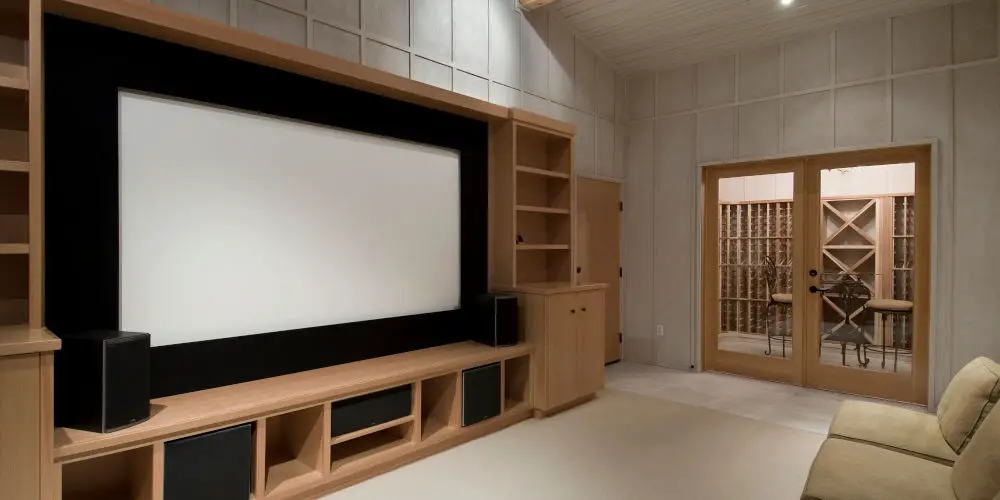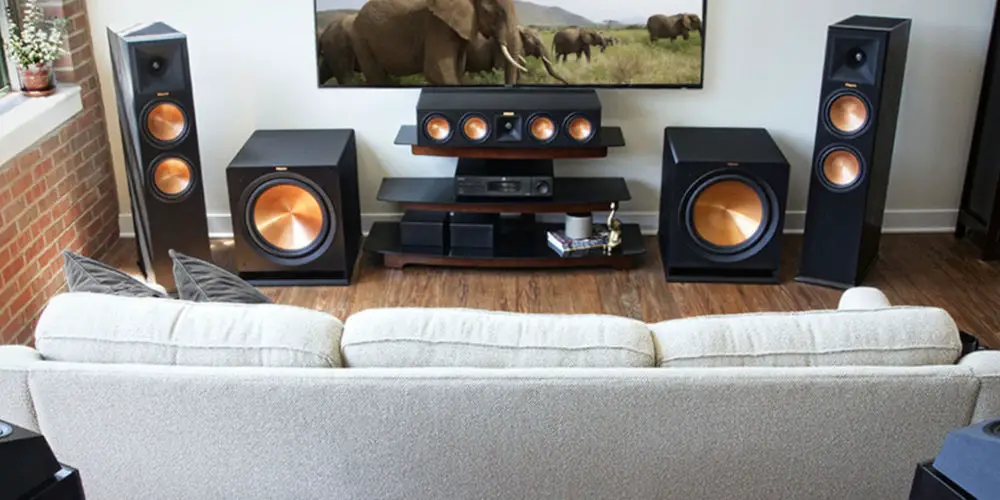Soundbar vs surround sound system in a cinema room

A challenge of building your first home cinema room is choosing the right speakers. Deciding between a soundbar vs surround sound system can be tricky, especially if you’re on a budget. But does one offer better sound quality or are the differences subtle?
Soundbars are highly popular, thanks to their stylish design, ease of install, and the instant improvement they provide to a TV’s poor sounding speakers. Some can even produce a virtual surround sound experience.
But will a soundbar replace a surround sound system with front, rear, and centre speakers, and subwoofer? Sadly, no soundbar will sound as rich as a proper home cinema speaker set up.
Consider this: soundbars are a superb upgrade to TV speakers. A surround sound system is the next audio step up from a soundbar. That said, many start their home cinema journey by using a soundbar with a projector. Next, they invest in an AV receiver and 5.1 speaker set up.
Let’s explore the pros and cons of a soundbar vs surround sound system, so you can decide what’s best for you.
What is a Soundbar?
Soundbars look like a long tube. Under the grille, there are typically four speakers but often more. Powering these speakers is an amplifier that splits the audio into multiple frequency bands. The amplifier uses specific speakers for different frequencies, creating a richer audio experience.
Compare the average soundbar and TV, and you’ll notice a massive change with the soundbar. Modern TVs have small speakers that are tightly packed and so are unable to move much. And as speakers need to push air to fully reproduce audio, most TV sound flat and lifeless.
At the bottom end, you can purchase a soundbar for as little as £20. That said some cost over £500. For that money, you’ll get a soundbar packed with features such as virtual surround sound, different audio modes for a range of situations and voice control (using Alexa or Google Assistant).
Some soundbars come with a subwoofer, offering an even richer sound experience. Such packages bridge the gap between poor sounding TV speakers, the basic soundbar and a surround sound system.
Finally, it’s super simple to connect a soundbar to a TV, projector, and Blu-ray player. Most soundbars have a few different inputs, typically optical, mini-jack and HDMI, so you can connect them with a single cable.
Soundbar pros
- Easy installation and connectivity
- Minimal wires
- Modern design
- Great for small-medium living spaces
- Excellent virtual sound, which simulates the surround sound experience.
Soundbar cons
- The soundbar’s placement creates specific “sweet spots” in your listening experience
- May not produce complete surround sound, especially in larger living environments
- You might end up buying a separate subwoofer for a punchy low end.

What is a surround sound system?
In the basic 5.1 surround sound system, the audio is divided up by frequency and location in the stereo field. The amplifier uses different speakers to reproduce the different frequencies while placing sounds where they should be for the ultimate listening experience.
A 5.1 system consists of six speakers (two front, two rear, centre and a subwoofer). A speaker sits on either side of the screen for music. Under the screen is a speaker that’s solely for dialogue. The rear speakers are used for sound effects, and the subwoofer handles the low frequencies.
Using a system like this, music sounds richer, and you can hear the dialogue. A car chase that moves across the screen will also move between speakers, making the whole experience feel more life-like. A bomb going off in your movie will sound like it’s happening in the room!
Simply put, a surround sound system brings the same level of detail as a 4K image. One without the other is fine, not great. However, surround sound with 4K pictures, and you’ll have the ultimate cinema for watching movies, all without needing to leave home!
It can take some time to set up and configure a surround sound system, even if you’re using a package like the Sony HT-S20R. You’ll need an AV receiver, five speakers, a powered subwoofer and cables. Not to mention the physical space you’ll need to get the best sound from the system.
Surround sound system pros
- Full range surround sound
- Able to place speakers in multiple stations for optimal acoustics
- Maximum bass
Surround sound system cons
- You’ll likely need to run wires from the receiver to each speaker
- Requires more space
- More involved installation process
- Expensive

Is using more speakers better?
Looks can be deceiving as having more speakers doesn’t always equal a better sound. If you mainly watch TV, a soundbar is probably a better option. Using a surround sound system for only TV is like using a hammer to crack a nut!
Similarly, watching movies using a soundbar is a vast improvement over a TV’s speaker but will sound lifeless compared to a home cinema style sound system. It’s the equivalent of using a push lawn mower to tackle 4 acres of overgrown land, possible but not the ideal tool!
Another element to consider is how much space you have. In a tiny snug, you won’t have the room to correctly position the different speakers, so a soundbar, preferably with a subwoofer, will be your best option.
If you have a large dedicated cinema room, having a surround sound system will produce eardrum pounding sound creating the ideal movie-watching environment. The investment will be more than worth it. Plus, you’ll be the envy of all of your friends!
Comparing a soundbar vs surround sound system
An extensive range of both soundbars and surround sound systems are available. So, you can base your decision on a multitude of factors such as price, features, or performance.
For example, a budget surround sound system will struggle to compete with the latest and most expensive Sony soundbar. The Sony unit might include multiple inputs, virtual Dolby Atmos, USB media player and voice control.
So, you’ll want to consider how each option performs and what features are essential to how you intend to use them. Here are some performance standards to consider when comparing a soundbar vs surround sound system.
Sensitivity
The speakers’ effectiveness of converting power (watts) into volume (decibels). The higher the sensitivity, the less power the speaker needs to deliver the effective sound. A higher sensitivity rating equals a loud, clear, high-quality sound.
Frequency Response
Humans can hear frequencies between 20 and 20,000 Hertz (Hz). Anything below 35 Hz is felt rather than heard (e.g. an explosion in a movie), and are produced by the subwoofer.
Be mindful of the frequency response range the device offers as you’ll better understand what kind of listening experience you will gain with the associated highs and lows that the speaker produces.
Power Handling
How much power, in watts, a speaker can handle before it is damaged. The higher the power handling, the more likely you are to upset the neighbours!
Impedance
How much electrical resistance is presented against the current flowing from your outputs? Impedance will fluctuate since the speaker will produce sounds at varying frequencies.
However, all manufacturers will publish a nominal impedance figure. Usually, this is 8 ohms, but some speakers can handle a 4-ohm load. Before purchasing a speaker, you should double-check that your AV receiver matches this load.

Which is best for your home cinema room?
On the surface comparing Soundbar vs surround sound system might seem like apples vs bananas. However, they achieve the same underlying goal of offering an improved audio experience. That said, you could argue that the soundbar is a Ford and the surround sound system is a Bentley.
If you’re just starting to build your first cinema room and the budget is tight, buy a soundbar with a subwoofer or the Sony HT-S20R. In time, you can invest in the kit you need for a 5.1 or 7.1 surround sound.
A soundbar will vastly improve your TV’s sound, bringing TV, movies and games to life. Plus, they are easy to set up and are compact. If you don’t have a lot of space, use a soundbar. However, if you’re aiming for the ultimate audiophile experience, you’ll want a surround sound system.
Hopefully, you have a clearer understanding of the differences between a soundbar vs surround sound system, and can now make a more informed purchase.




